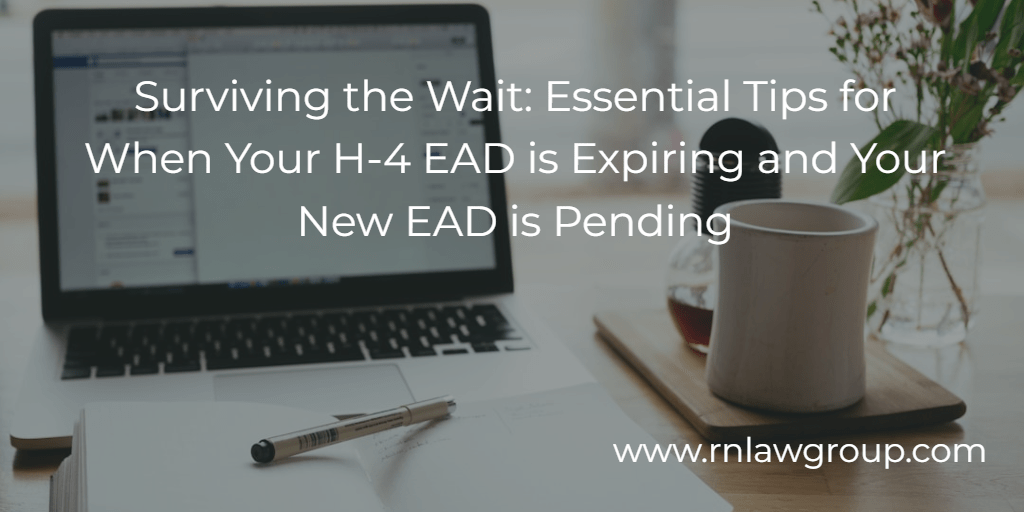
Surviving the Wait: Essential Tips for When Your H-4 EAD is Expiring and Your New EAD is Pending
The expiration of an H-4 Employment Authorization Document (EAD) while a renewal is still pending can be a significant source of stress and uncertainty for many H-4 visa holders. These delays often occur for various reasons, including the inability to file the H-4 EAD concurrently with the H-1B petition, which can lead to separate and prolonged processing times. Additionally, despite a litigation settlement that requires the U.S. Citizenship and Immigration Services (USCIS) to process bundled I-129 (H-1B), I-539 (H-4), and I-765 (EAD) applications together, there are instances where USCIS does not adhere to this agreement, resulting in further delays. Understanding these causes and knowing how to navigate this challenging period is crucial for maintaining employment and legal status in the United States.
Understanding the Limits of Automatic EAD Extensions
The automatic EAD extension policy offers a temporary reprieve for some H-4 EAD holders, but it does not apply universally to all H-4 EAD renewals. To qualify for this automatic extension, the individual’s H-4 status must already be extended, which means possessing an I-94 document valid beyond the expiration date of the current EAD. Without an extended I-94, the automatic extension cannot be granted, leaving many H-4 visa holders in a precarious position as they await the approval of their renewal applications. This requirement underscores the importance of timely and concurrent filing of H-4 status extensions and EAD renewals to minimize employment interruptions and maintain legal work authorization.
Proactive Strategies to Avoid EAD Processing Delays
To minimize delays in EAD processing, it is crucial to adopt proactive strategies. Filing renewals as early as possible, ideally up to 180 days before the current EAD expiration, can help ensure a smoother transition and reduce the risk of employment gaps. Additionally, bundling the H-4 EAD renewal with an H-1B extension can expedite processing times, as USCIS is required to handle these bundled applications together. In cases where an H-1B extension is not yet due, consider filing an H-1B amendment solely for the purpose of bundling it with the H-4 and EAD applications. This strategic approach can significantly cut down on delays, ensuring continuous work authorization and peace of mind.
Resolving Delays Due to Non-Compliance with Settlement Agreements
When an EAD renewal is delayed and the current EAD is expiring due to USCIS not complying with the settlement agreement to process bundled applications together, there are steps that can be taken to resolve the issue. In such situations, it is advisable for the employer or the employer’s attorney to contact the premium processing unit that approved the H-1B petition. They should remind the unit of the requirement to bundle the H-4 and EAD applications for concurrent adjudication. This intervention typically prompts USCIS to expedite the processing of the H-4 EAD, often resulting in its swift approval. It is important to note that only the employer or the employer’s attorney can initiate this contact, as it pertains to the H-1B processing, and the H-1B beneficiary is not authorized to inquire about their case directly with USCIS.
Additional Options When EAD Delays Occur
When an EAD renewal is delayed and the current EAD is expiring, and the situation does not involve a bundled application, there are still actions that can be taken. One option is to call USCIS to request expedited processing, provided that the request meets USCIS expedite criteria, such as severe financial loss to the company or individual, urgent humanitarian reasons, or other compelling circumstances. Additionally, if the EAD renewal application is outside the normal processing times, the H-4 holder can submit a service request to USCIS. This service request can help bring attention to the delayed application and may expedite its adjudication. Taking these steps can potentially mitigate the impact of delays and help maintain continuous employment authorization.
Leveraging Travel for a New I-94 and Automatic EAD Extension
If the previous options do not apply or fail to resolve the delay, there is another potential solution to activate the automatic EAD renewal. This involves obtaining a new I-94 outside of USCIS by traveling to Mexico. For this to be feasible, the H-1B extension must already be approved, the H-4 visa holder must possess a valid visa, and their current I-94 must not have expired yet. By traveling to Mexico and re-entering the United States with the H-1B holder’s extended I-94, the H-4 visa holder can often obtain a new I-94 valid to the new H-1B expiration date, which then triggers the automatic EAD extension for the pending I-765 application. This method can provide the necessary work authorization while awaiting the pending EAD renewal. If the H-4 visa stamp has already expired but the current H-4 I-94 has not yet expired, traveling to Mexico using Automatic Visa Revalidation might still be a viable option to obtain a new I-94. However, in this scenario, the H-4 visa holder may need to obtain a Mexican visa to enter Mexico. It’s essential to verify the specific entry requirements for Mexico, as they can vary based on nationality and other factors. By ensuring all necessary visas and documents are in order, this method can provide an opportunity to get a new I-94, which may help activate the automatic EAD extension while waiting for the renewal to be processed. Always check the latest travel and entry requirements to avoid any complications.
Applying for a New H-4 Visa as a Last Resort
As a last resort, if all other options fail and the H-1B extension is already approved, the H-4 spouse can exit the United States and apply for a new H-4 visa at a U.S. consulate or embassy abroad based on the spouse’s extended H-1B approval. Once the new H-4 visa stamp in the passport is obtained and the H-4 spouse re-enters the US, a new I-94 will be issued with an updated expiration date that matches the H-1B approval. This new I-94, coupled with the timely filing of the I-765 (filed before the previous EAD expires), will fulfill the requirements for the automatic extension of the EAD. This process, although more time-consuming and potentially costly, can ensure continued work authorization while waiting for the EAD renewal to be processed.
Conclusion: Overcoming H-4 EAD Challenges
While the H-4 EAD offers the significant benefit of enabling a dual income for immigrant families, it is not without its challenges. Handling the complexities of EAD renewals, dealing with potential delays, and ensuring continuous work authorization requires strategic planning and sometimes creative solutions. Understanding the various options available, from early filing and bundling applications to leveraging travel for a new I-94, can help mitigate the risks associated with these delays. Despite the obstacles, staying informed and proactive can ensure that H-4 visa holders continue to enjoy the advantages of the EAD program.
For over 25 years, Reddy Neumann Brown PC has focused solely on U.S. employment-based immigration, and works with employers to establish best practices when navigating the PERM labor certification process. If you are in need of a U.S. work visa or permanent residency, speak with one of our immigration lawyers. Please contact us online, call our Houston business immigration office directly at 713-953-7787 or schedule a consultation.
By: Emily Neumann
Emily Neumann is Managing Partner at Reddy Neumann Brown PC with over 15 years of experience practicing US immigration law providing services to U.S. businesses and multinational corporations. Emily has helped transform the firm from a solo practice to Houston’s largest immigration law firm focused exclusively on U.S. employment-based immigration. She received her Bachelor’s degree in Biology from Central Michigan University and her Juris Doctorate degree from the University of Houston Law Center. Emily is a frequent speaker and has been quoted in Forbes, Bloomberg Law, U.S. News & World Report, Inside Higher Ed, and The Times of India on various hot topics in immigration. She is a member of the American Immigration Lawyers Association and Society for Human Resource Management.

